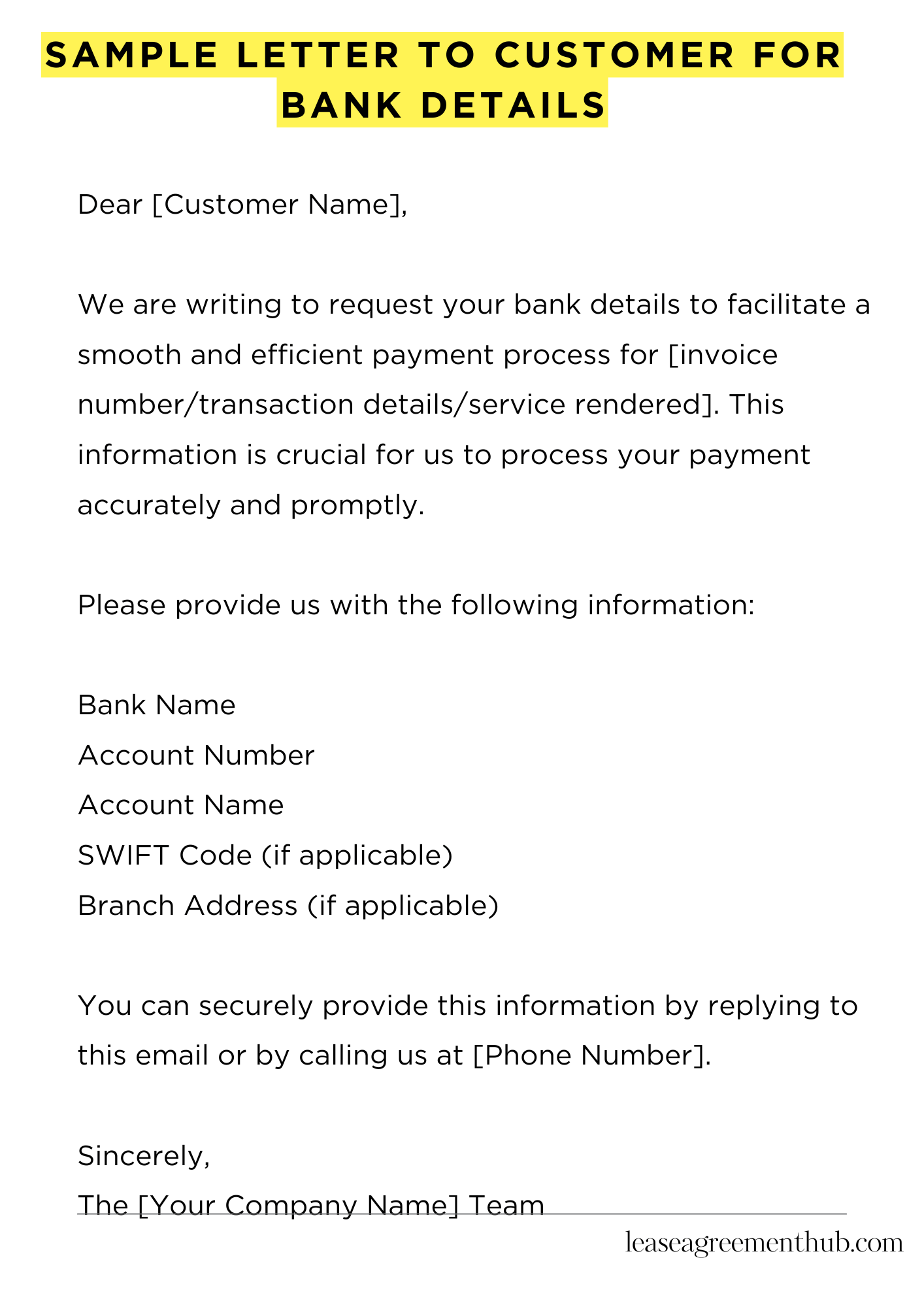Are you looking for a simple and effective way to request bank details from your customers? Our blog article on “sample letter to customer for bank details” is here to help.
We understand the importance of clear communication when it comes to financial matters. That’s why we have compiled a variety of templates and examples of letters that you can use to request bank details from your customers.
With our easy-to-use samples, you can quickly and confidently reach out to your customers and collect the information you need to process payments or update account details. Let us take the guesswork out of writing these important letters for you.
sample letter to customer for bank details
[Your Company Letterhead]
[Date]
[Customer Name]
[Customer Address]
Dear [Customer Name],
We are writing to request your bank details to facilitate a smooth and efficient payment process for [invoice number/transaction details/service rendered]. This information is crucial for us to process your payment accurately and promptly.
Please provide us with the following information:
Bank Name
Account Number
Account Name
SWIFT Code (if applicable)
Branch Address (if applicable)
You can securely provide this information by replying to this email or by calling us at [Phone Number]. We understand the importance of protecting your financial information, and we assure you that all data will be handled with the utmost confidentiality and security, in accordance with our privacy policy.
We appreciate your cooperation in this matter. Your prompt response will ensure that your payment is processed without delay. Contact us if you have any questions or require further clarification.
Sincerely,
The [Your Company Name] Team

How to Write a Sample Letter to Customer for Bank Details
The Imperative of Clarity and Conciseness
Requesting sensitive information like bank details necessitates meticulous crafting. Ambiguity is your nemesis. Your letter must be crystal clear, leaving no room for misinterpretation. Brevity is key; avoid verbose prose. Get straight to the point.
Establishing a Professional Tone
Maintain a formal and professional tone throughout. Avoid colloquialisms or overly familiar language. This isn’t a casual email; it’s a formal request for sensitive financial data. Your letter should reflect the gravity of the situation and your organization’s professionalism. Employ precise diction to convey a sense of authority and trustworthiness.
Crafting a Cogent Introduction
Begin by identifying yourself and your organization explicitly. State the purpose of your letter succinctly. For example, start with “This letter formally requests your bank details to facilitate [specific purpose, e.g., payment processing, refund disbursement].” Avoid circumlocution; be direct and to the point.
Articulating the Rationale
Clearly explain *why* you need the customer’s bank details. Transparency builds trust. Simply stating “We need this information for payment” is insufficient. Specify the transaction type, relevant invoice number, or the specific service for which payment is due. Be explicit and unambiguous in your explanation to avoid any suspicion or hesitation.
Specifying Required Information
List the precise bank details required. This might include account name, account number, bank name, SWIFT code (if applicable), and branch address. Use bullet points for clarity. Include a sample format if it helps alleviate any confusion on the customer’s part. Consider providing a downloadable template for improved accuracy.
Ensuring Data Security and Confidentiality
Reassure your customer about the security measures in place to protect their sensitive information. Mention your organization’s adherence to data protection regulations (e.g., GDPR, CCPA). Emphasize your commitment to confidentiality. This reassurance can alleviate concerns and encourage prompt compliance. Highlight any encryption protocols you employ.
Concluding with a Call to Action and Contact Information
Provide clear instructions on how and where to submit the bank details. Include a deadline for submission. Offer multiple contact channels (phone number, email address) for any queries. End with a formal closing, such as “Sincerely,” followed by your name and title. This creates a sense of completion and professionalism, leaving a positive and lasting impression.
FAQs about sample letter to customer for bank details
What information should be included in a letter requesting bank details from a customer?
A letter requesting bank details should clearly state the purpose of needing the information, the specific details required (account name, account number, bank name, SWIFT code if applicable), and assure the customer of the security measures in place to protect their data. It should also include contact information for any questions or concerns.
How can I ensure the letter maintains customer confidentiality and complies with data protection regulations?
Use secure methods of sending the letter (e.g., registered mail or secure email). Clearly state your company’s data protection policy and how customer data will be handled. Ensure compliance with relevant regulations like GDPR or CCPA, depending on your location and the customer’s location.
What is the best way to phrase the request for sensitive information to avoid sounding suspicious?
Use professional and courteous language. Explain the necessity of the information in a transparent and straightforward manner, emphasizing the benefits to the customer (e.g., processing payments, refunds, etc.). Avoid vague or ambiguous wording.
What should I do if a customer refuses to provide their bank details?
Respect the customer’s decision. Explain the consequences of not providing the information (e.g., inability to process payments) and offer alternative solutions if possible. Document the customer’s refusal and follow your company’s established procedures.
Is it acceptable to request bank details via email?
While email is convenient, it’s generally not recommended for requesting sensitive information like bank details due to security risks. Consider using more secure methods such as registered mail or a secure online portal with encryption.
Related: